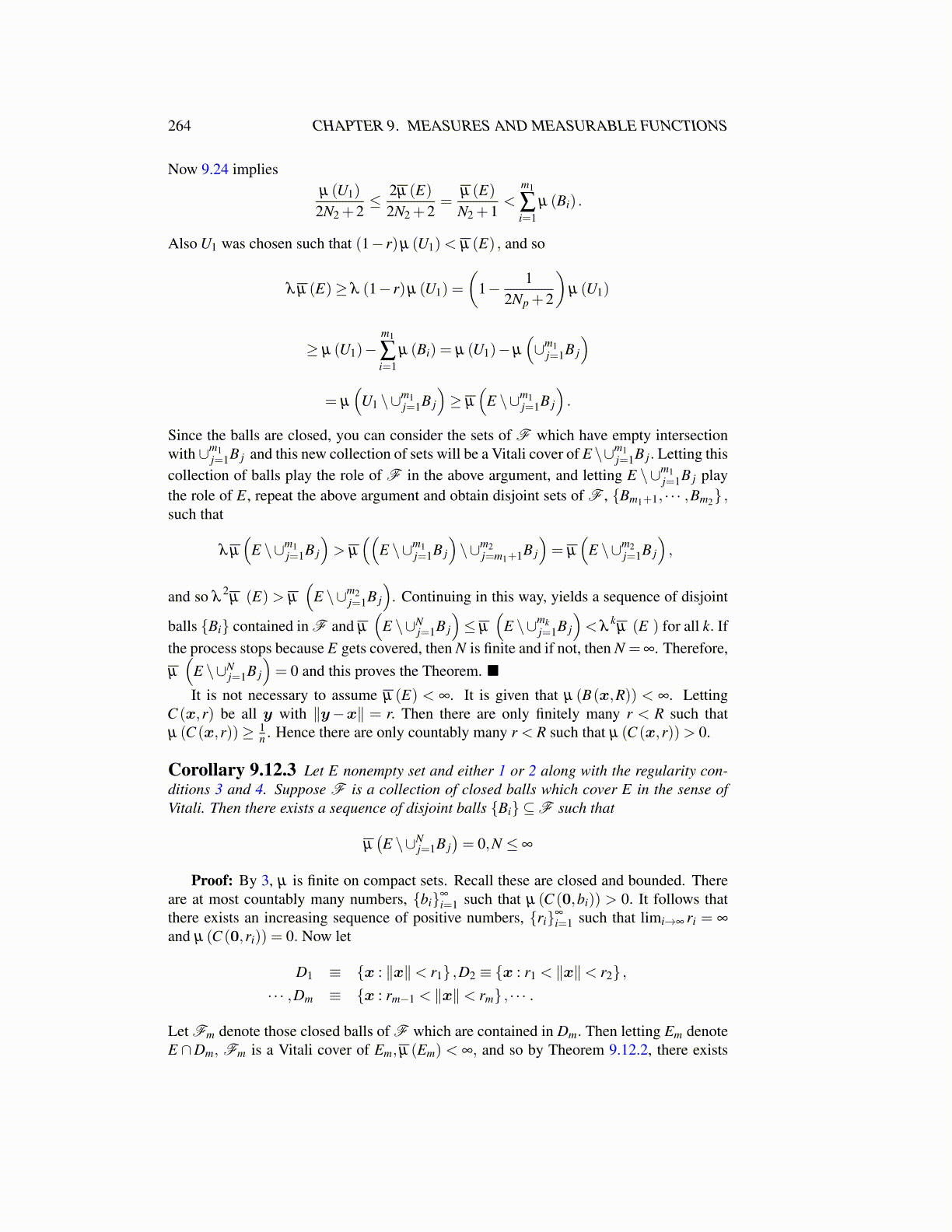
264 CHAPTER 9. MEASURES AND MEASURABLE FUNCTIONS
Now 9.24 impliesµ (U1)
2N2 +2≤ 2µ (E)
2N2 +2=
µ (E)N2 +1
<m1
∑i=1
µ (Bi) .
Also U1 was chosen such that (1− r)µ (U1)< µ (E) , and so
λ µ (E)≥ λ (1− r)µ (U1) =
(1− 1
2Np +2
)µ (U1)
≥ µ (U1)−m1
∑i=1
µ (Bi) = µ (U1)−µ
(∪m1
j=1B j
)= µ
(U1 \∪m1
j=1B j
)≥ µ
(E \∪m1
j=1B j
).
Since the balls are closed, you can consider the sets of F which have empty intersectionwith ∪m1
j=1B j and this new collection of sets will be a Vitali cover of E \∪m1j=1B j. Letting this
collection of balls play the role of F in the above argument, and letting E \∪m1j=1B j play
the role of E, repeat the above argument and obtain disjoint sets of F , {Bm1+1, · · · ,Bm2} ,such that
λ µ
(E \∪m1
j=1B j
)> µ
((E \∪m1
j=1B j
)\∪m2
j=m1+1B j
)= µ
(E \∪m2
j=1B j
),
and so λ2µ (E)> µ
(E \∪m2
j=1B j
). Continuing in this way, yields a sequence of disjoint
balls {Bi} contained in F and µ
(E \∪N
j=1B j
)≤ µ
(E \∪mk
j=1B j
)< λ
kµ (E ) for all k. If
the process stops because E gets covered, then N is finite and if not, then N =∞. Therefore,µ
(E \∪N
j=1B j
)= 0 and this proves the Theorem. ■
It is not necessary to assume µ (E) < ∞. It is given that µ (B(x,R)) < ∞. LettingC (x,r) be all y with ∥y−x∥ = r. Then there are only finitely many r < R such thatµ (C (x,r))≥ 1
n . Hence there are only countably many r < R such that µ (C (x,r))> 0.
Corollary 9.12.3 Let E nonempty set and either 1 or 2 along with the regularity con-ditions 3 and 4. Suppose F is a collection of closed balls which cover E in the sense ofVitali. Then there exists a sequence of disjoint balls {Bi} ⊆F such that
µ(E \∪N
j=1B j)= 0,N ≤ ∞
Proof: By 3, µ is finite on compact sets. Recall these are closed and bounded. Thereare at most countably many numbers, {bi}∞
i=1 such that µ (C (0,bi)) > 0. It follows thatthere exists an increasing sequence of positive numbers, {ri}∞
i=1 such that limi→∞ ri = ∞
and µ (C (0,ri)) = 0. Now let
D1 ≡ {x : ∥x∥< r1} ,D2 ≡ {x : r1 < ∥x∥< r2} ,· · · ,Dm ≡ {x : rm−1 < ∥x∥< rm} , · · · .
Let Fm denote those closed balls of F which are contained in Dm. Then letting Em denoteE ∩Dm, Fm is a Vitali cover of Em,µ (Em) < ∞, and so by Theorem 9.12.2, there exists